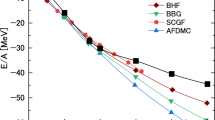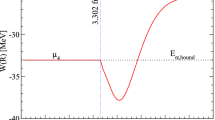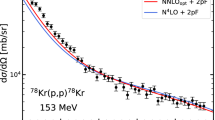Abstract
A new formalism of nuclear matter, called “tensor-optimized Fermi sphere (TOFS) method”, is developed to handle the nuclear matter using a bare interaction among nucleons. In this formalism, the correlated nuclear matter wave function is taken to be a power-series type of the correlation function F, \(\varPsi _{N}=[\sum _{n=0}^{N} (1/n!)F^{n}]\varPhi _{0}\), where F can induce central, spin-isospin, tensor, spin-orbit, etc. correlation, and \(\varPhi _{0}\) is the uncorrelated Fermi-gas wave function. The validity of our formalism is based on a linked-cluster expansion theorem established in the TOFS theory with Hermitian form. The connection between \(\varPsi _{N}\) and an exponential type correlated nuclear matter wave function, \(\varPsi _{ex}=\exp (F) \varPhi _{0}\), is emphasized to lead to the theorem. The framework of TOFS is a variational method, in which the correlation function F is determined by minimizing the energy per particle in nuclear matter with respect to the nuclear matter wave function \(\varPsi _{N}\). The first application of the TOFS theory is performed to study the property of nuclear matter using the Argonne V4’ NN potential. It is found that the density dependence of the energy per particle in nuclear matter is reasonably reproduced up to the nuclear matter density \(\rho \simeq 0.20\) \(\hbox {fm}^{-3}\), in comparison with other methods such as the Brueckner-Hartree-Fock (BHF) approach. We discuss the explicit contributions of many-body terms in the total energy, and indicate the importance of higher-body terms.
Similar content being viewed by others
Data Availability Statement
This manuscript has no associated data or the data will not be deposited. [Authors’ comment: The relevant data are given in the tables. They can also be obtained from the author.]
References
K.A. Brueckner, C.A. Levinson, Phys. Rev. 97, 1344 (1955)
K.A. Brueckner, Phys. Rev. 100, 36 (1955)
K.A. Brueckner, J.L. Gammel, Phys. Rev. 109, 1023 (1958)
H.A. Bethe, Phys. Rev. 103, 1353 (1956)
H.A. Bethe, J. Goldstone, Proc. Roy. Soc. A238, 551 (1957)
J. Goldstone, Proc. Roy. Soc. A239, 267 (1957)
C. Mahaux, R. Sartor, in Nuclear Matter and Heavy Ion Collisions, edited by M. Soyeur et al., NATO Advanced Study Institute Ser. B, Vol. 205 (Plenum Press,New York, 1989)
M. Baldo, I. Bombaci, L.S. Ferreira, G. Giansiracusa, U. Lombardo, Phys. Rev. C 43, 2605 (1991)
H.-J. Schulze, J. Cugnon, A. Lejeune, M. Baldo, U. Lombardo, Phys. Rev. C 52, 2785 (1995)
B.D. Day, Rev. Mod. Phys. 39, 719 (1967). (and references therein)
B.D. Day, in Brueckner-Bethe Calculations of Nuclear Matter, Proceedings of the International School of Physics “Enrico Fermi” Course LXXIX, edited by A. Molinari (Editrice Compositori, Bologna, 1983), pp. 1-72
H.Q. Song, M. Baldo, G. Giansiracusa, U. Lombardo, Phys. Rev. Lett. 81, 1584 (1998)
M. Baldo, G. Giansiracusa, U. Lombardo, H.Q. Song, Phys. Lett. B 473, 1 (2000)
M. Baldo, A. Fiasconaro, H.Q. Song, G. Giansiracusa, U. Lombardo, Phys. Rev. C 65, 017303 (2001)
R. Sartor, Phys. Rev. C 73, 034307 (2006)
W.H. Dickhoff, C. Barbieri, Prog. Part. Nucl. Phys. 52, 377 (2004)
T. Frick, H. Müther, A. Rios, A. Polls, A. Ramos, Phys. Rev. C 71, 014313 (2005)
V. Somà, P. Bozėk, Phys. Rev. C 74, 045809 (2006)
V. Somà, P. Bozėk, Phys. Rev. C 78, 054003 (2008)
A. Rios, A. Polls, I. Vidaña, Phys. Rev. C 79, 025802 (2009)
S. Gandolfi, F. Pederiva, S. Fantoni, K.E. Schmidt, Phys. Rev. Lett. 98, 102503 (2007)
S. Gandolfi, A.Y. Illarionov, K.E. Schmidt, F. Pederiva, S. Fantoni, Phys. Rev. C 79, 054005 (2009)
J. Carlson, J. Morales, V.R. Pandharipande, D.G. Ravenhall, Phys. Rev. C 68, 025802 (2003)
F. Iwamoto, M. Yamada, Prog. Theor. Phys. 17, 543 (1957)
S. Fantoni, S. Rosati, Nuovo Cimento A 10, 145 (1972)
S. Fantoni, S. Rosati, Nuovo Cimento A 20, 179 (1974)
S. Fantoni, S. Rosati, Nuovo Cimento A 43, 413 (1978)
V.R. Pandharipande, R.B. Wiringa, Rev. Mod. Phys. 51, 821 (1979)
A. Akmal, V.R. Pandharipande, D.G. Ravenhall, Phys. Rev. C 58, 1804 (1998)
G. Baardsen, A. Ekström, G. Hagen, M. Hjorth-Jensen, Phys. Rev. C 88, 054312 (2013)
G. Hagen, T. Papenbrock, M. Hjorth-Jensen, D.J. Dean, Rep. Prog. Phys. 77, 096302 (2014)
R.B. Wiringa, V.G.J. Stoks, R. Schiavilla, Phys. Rev. C 51, 38 (1995)
M. Baldo, A. Polls, A. Rios, H.-J. Schulze, I. Vidaña, Phys. Rev. C 86, 064001 (2012)
T. Yamada, Ann. Phys. 403, 1 (2019)
T. Yamada, T. Myo, H. Toki, H. Horiuchi, K. Ikeda, Prog. Theor. Exp. Phys. 2019, 113D03 (2019)
T. Myo, H. Toki, K. Ikeda, H. Horiuchi, T. Suhara, Prog. Theor. Exp. Phys. 2015, 073D02 (2015)
T. Myo, H. Toki, K. Ikeda, H. Horiuchi, T. Suhara, Phys. Lett. B 769, 213 (2017)
G. Có, A. Fabrocini, S. Fantoni, Nucl. Phys. A 568, 73 (1994)
F. Arias de Saavedra, C. Bisconti, G. Có, A. Fabrocinic, Phys. Rep. 450, 1 (2007)
H. Kümmel, H.K. Lührmann, J.G. Zabolitzky, Phys. Rep. 36, 1 (1978)
R. Barlett, Ann. Rev. Phys. Chem. 32, 359 (1981)
Acknowledgements
We are grateful to Profs. T. Myo, H. Toki, H. Horiuchi, and K. Ikeda for useful discussions. This work was partially supported by the JSPS KAKENHI Grans No. 26400283. The ECT* Trento has supported this work and this infrastructure is part of a project that has received funding from the European Union’s Horizon 2020 research and innovation programme under Grant agreement No. 824093.
Author information
Authors and Affiliations
Corresponding author
Additional information
Communicated by David Blaschke
Rights and permissions
About this article
Cite this article
Yamada, T. A new formalism of nuclear matter: tensor-optimized Fermi sphere method. Eur. Phys. J. A 57, 73 (2021). https://doi.org/10.1140/epja/s10050-021-00383-1
Received:
Accepted:
Published:
DOI: https://doi.org/10.1140/epja/s10050-021-00383-1




